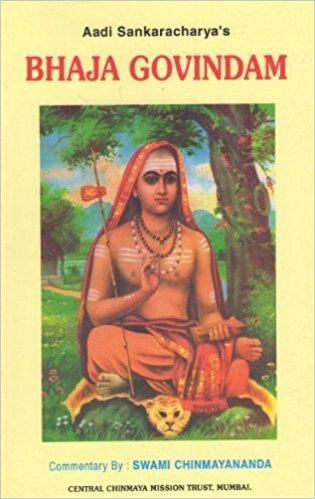 | ||
Similar Adi Shankara books, Other books | ||
Bhaja Govindam [Praise/Seek Govinda (Vishnu)] also known as Moha Mudgara (Hammer [to shatter] illusion) is a popular 8th century Hindu devotional composition in Sanskrit attributed to Adi Shankara. This work of Adi Shankara underscores the view that devotion (Bhakti) to God, Govinda, is a vastly important part of general spirituality, as emphasised by Bhakti Yoga and the Bhakti movement. This work is generally considered a summary of Adi Shankara's Advaita Vedanta philosophy.
Contents
Bhaja govindam adi shankara
Sanskrit Text
The first stanza of the composition, featuring the eponymous line "Bhaja Govindam", reads as follows:
Significance
This composition is a reminder that the author, Adi Shankaracharya, who is often regarded as a stalwart advocate of the Jnana Marga (Jnana Yoga) or the "Path of Knowledge" to attain Mukti, yielded to none in appreciating, indeed enjoining the Bhakti Marga (Bhakti Yoga) or the "Path of Faith/Devotion" to the same goal, and as C. Rajagopalachari put in his commentary, "When intelligence (jnana) matures and lodges securely in the heart, it becomes wisdom (vignyana). When that wisdom (vignyana) is integrated with life and issues out in action, it becomes devotion (bhakti). Knowledge (jnana) which has become mature is spoken of as devotion (bhakti). If it does not get transformed into devotion (bhakti), such knowledge (jnana) is useless tinsel."
In this prayer, Adi Shankaracharya emphasizes the importance of devotion for God as a means to spiritual development and to liberation from the cycle of birth and death. The prayer leaves one in no doubt that the renunciation of our egotistical differences and surrender to God makes for salvation. Many scholars hold that this composition encapsulates with both brevity and simplicity the substance of all Vedantic thought found in whatever other works that Adi Shankaracharya wrote:
The refrain "Bhaja Govindam" which defines the composition and gives it its name invokes the almighty in the aspect of Vishnu; it is therefore very popular not only with Sri Adi Shankaracharya's immediate followers, the Smarthas, but also with Vaishnavas and others.
Meter / Chandas
The metre is moraic (मात्राछन्दस्). Apart from the first verse, all other verses have 16 mAtrAs, which tend to fit the description of the pAdakulakam variety of mAtrAsamaka [मात्रासमक] in vRtta-ratnAkara.
Legend
There is a story attached to the composition of this Hymn. It is said that Shri Adi Shankaracharya, accompanied by his disciples, was walking along a street in Varanasi one day when he came across an aged scholar reciting the rules of Sanskrit grammar repeatedly on the street to earn more money from any students who would be interested in learning it. On watching this, Adi Shankaracharya in anger went up to the scholar and advised him not to waste his time on Drukrukarane rules of Grammar at his age but to turn his mind to God in worship and adoration which would only save him from this vicious cycle of life and death and not the money earned through the teaching of the rules of Grammar. The hymn "Bhaja Govindam" is said to have been composed on this occasion.
The composition consists of thirty-three verses. Besides the refrain of the song beginning with the words "Bhaja Govindam", Shankaracharya is said to have sung twelve other verses. Hence, the hymn bears the title "Dvadasamanjarika-Stotra" (A hymn which is a bunch of twelve verse-blossoms). The fourteen disciples who were with the Master on that occasion are believed to have added one verse each. These fourteen verses are together called "Chaturdasa-manjarika-Stotra" (a hymn consisting of fourteen verse-blossoms).
The rendition of this hymn by M. S. Subbulakshmi is very popular.
